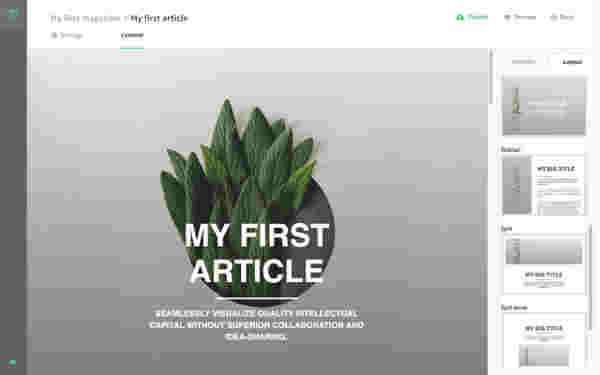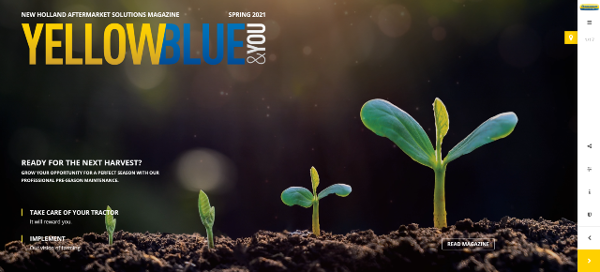
COVID-19 and digitization
Boost or crisis? A COVID-19 comparison between digital and print
Container for the scroll indicator
(Will be hidden in the published article)
Due to the Covid19 pandemic, challenges for the corporate world have increased. At the same time, digitization is experiencing an enormous progress - and with it the switch from print to digital. Has print become redundant? Will digital magazines completely replace their printed counterparts from now on? In this article we will lead you through the development of print and digital media - and also we will recommend to you what’s best to offer your readers in future.
COVID-19 has been and still is affecting many areas of our lives with incredible speed. The crisis not only affects purchasing behavior, but also activities of marketing departments. Since the world has been confronted by the virus, companies (especially during lockdowns) have experienced a much harder time even reaching their potential buyers. Meetings and events?! Canceled! Campaigns?! Often miss the mark or don’t even start.
While some companies went through difficult times to make changes to pre-produced print publications, it was easy to adjust publications online. For printed publications there was no more option than being published unchanged or not at all. Both time and money were wasted. Online magazines were able to continue as usual as they were able to react flexible to any upcoming changes. Another advantage: staying in touch with their customers was possible at any time.
"COVID-19 boost" : Crisis as a digitization activator
More online media consumption, more and more digital subscribers, and so: more digital revenues - Covid19 has clearly changed consumer behavior and accelerated developments. Digital offers have been rising and rising - not least due to the current pandemic. The acceptance of digital technologies keeps on growing and their use is still increasing. Digital working methods and production methods have become common practice for plenty of companies within the last months.
The crisis comes with it a massive boost in digitization. Especially the combination of stationary business and e-commerce is breaking the boundaries between the digital and the analog world - and is fundamentally changing the customer journey. Sure, the ongoing digital change has been controlling most industries and corporate divisions for years now. Digital sales and marketing communication picked up significantly - and this didn’t start just now due to the pandemic. But COVID-19 speeded up the whole process and transformed the storm of digitization into a hurricane in this area too.
The ongoing digital change has been controlling most industries and corporate divisions for years now. Digital sales and marketing communication picked up significantly - and this didn’t start just now due to the pandemic. But COVID-19 speeded up the whole process and transformed the storm of digitization into a hurricane in this area too.
Post COVID-19: How has the market changed?
Figures prove: The consequences of the Covid19 crisis are putting high pressure on the medium of print which leads to the fact that digital offers are being used significantly more often today. Due to current figures of the German Audit Bureau of Circulation (IVW), we know that the reach of online news offers have skyrocketed. On the opposite: many print media plummeted completely during the crisis.
In addition, print media is suffering from reduced advertising budgets. Market information from Statista Advertising & Media Outlook shows that magazines are affected in particular. Quite the contrary happened to digital advertising: the development is entirely positive. The EHI Retail Institute published numbers regarding current and upcoming marketing budgets (2021-2024): 43 percent of in total 55 interviewed CMO´s of German retail companies indicated an increasing or remaining marketing budget. 56 percent are meant to get along with less budget than before (survey from March/April 2021). Only around 30 percent of the total marketing budget ended up being invested in print media such as brochures. A good 34 percent of the expenses are being spend for digital media. According to the 2024 forecast, digital media expenses will be increasing by another 4 percent, while traditional media will lose another 7 percent.
Need an example for a digital magazine?
Click here for NEW HOLLAND's digital customer magazine.
Cost savings through digital marketing
For the first time, print advertising ranks second in comparison of marketing measures. The reasons for this are obvious: demand is falling as customers prefer to read online. Therefor, classic print media is being questioned completely for the first time ever. On top of this: companies in a rather tense situation need to prioritize their expenses. The meaning of the cost-benefit ratio as an economic controlling tool is great, especially in times of tight budgets.
Additionally those people in charge were aiming for cost reduction. Marketing departments weren’t an exemption here. Loss of sales and revenue increases awareness of efficiency.
Printed media is more cost-intensive and also requires a longer lead time. Regarding falling circulation figures and rising printing and distribution costs at the same time, print media are therefore one of the cost centers where the pressure of change is particularly high. On the other hand, smart communication with customers via digital channels is easy and possible in real time. Digital publications are more up-to-date, produced faster and with significantly lower financial effort. Let´s say: more effective and efficient.
Big data as a crisis winner
Data has also act central a part for companies since the beginning of the COVID-19 crisis. To understand customers and their behavior a correct interpretation of data is essential. During the crisis there were rapid changes in consumer behavior. Anyone who has interpreted and understood data correctly develops a more complex understanding of both their existing and their future customers a significant competitive advantage.
This also shows the big importance of digital flexibility. It's not just about marketing and selling as many products as possible, it's also about creating a brand and taking care of customers. This is even more difficult by using traditional materials only. Companies need to understand how their customers' needs change and react to this. The effect of digital solutions can be measured in every single detail.
Using integrated analysis tools with digitial solutions, you can find out what readers and customers are really looking for.
Hybrid strategies: mix of digital formats and print
The pandemic asks for us to consistently rethink in many ways. Existing processes must be questioned and might need to be redesigned. But where do you start?
Companies are encouraged to adapt their communication measures to the behavior of their (potential) customers. Nowadays, this means: responding quickly to external changes and optimizing any expenses. Impossible for companies who don’t work digitally.
Print is still important, especially for companies whose digital processes aren’t fully developed yet. Also print makes information manageable and more concrete. Digital publications, on the other hand, lighten the exchange. Digital information and documents can be provided quickly, flexibly and inexpensively - they are measurable, can be spread in a targeted manner - and are therefore gaining more importance.
Conclusion: Think digital first
The reactions to the current COVID-19-crisis proves that digital communication is more of an up-to date solution than print, because its production is cheaper and faster, they are more up-to-date and more flexibly. Print is far from dead. But: the focus is shifting and the overall volume is decreasing. Compared to the print medium, digital media are still gaining more importance. COVID-19 has given digital penetration another boost and it has become even more natural to consume information online.
In conclusion: it will always be important to learn from current events and to prepare for future challenges continuously. In concrete terms: creating new digital channels, using budgets for digital communication and increasing digital visibility.
Switch to digital now
With Webmag you can easily create, publish, communicate and evaluate digital publications yourself. Send us your format as a PDF and we will create a digital sample view for you. Free.


Container for the dynamic page
(Will be hidden in the published article)

